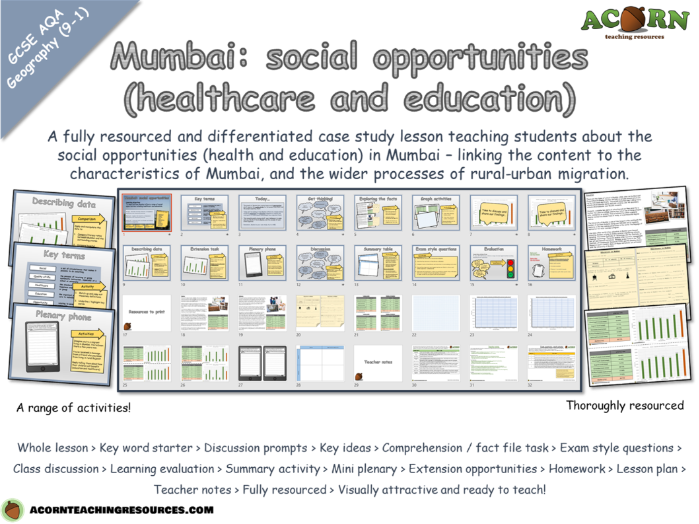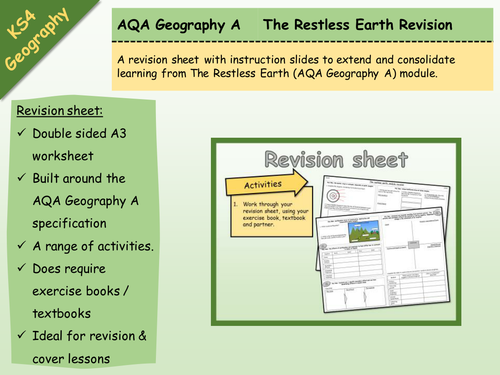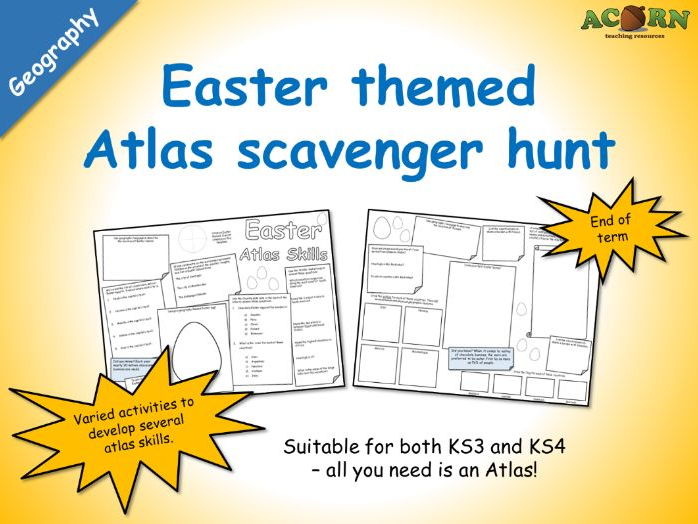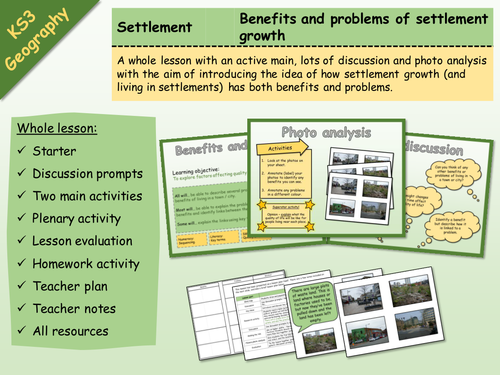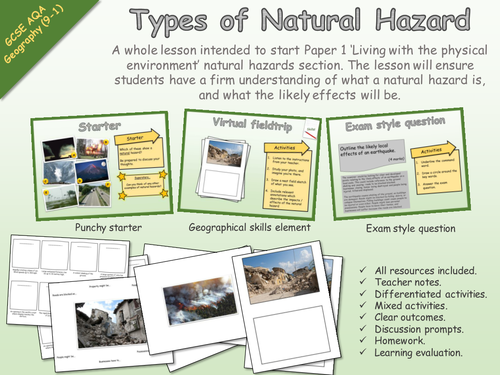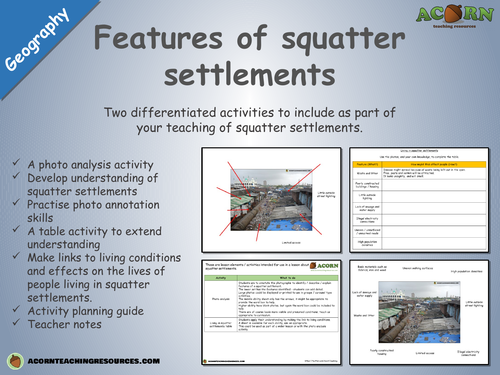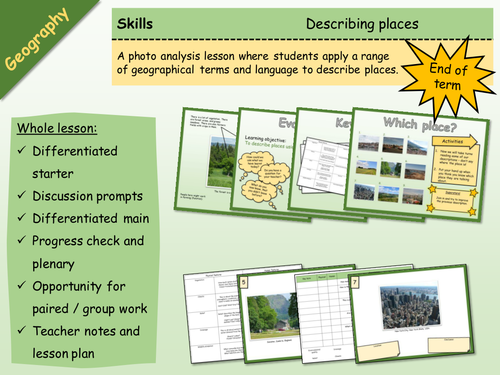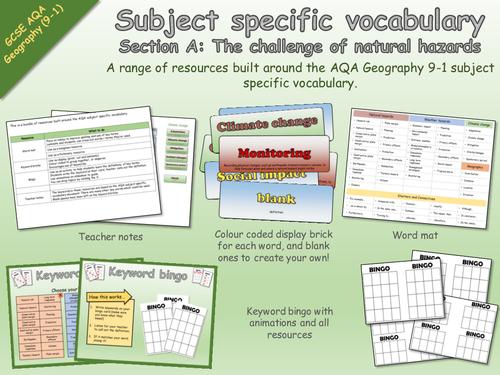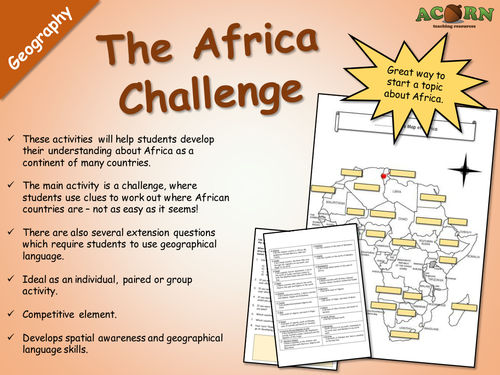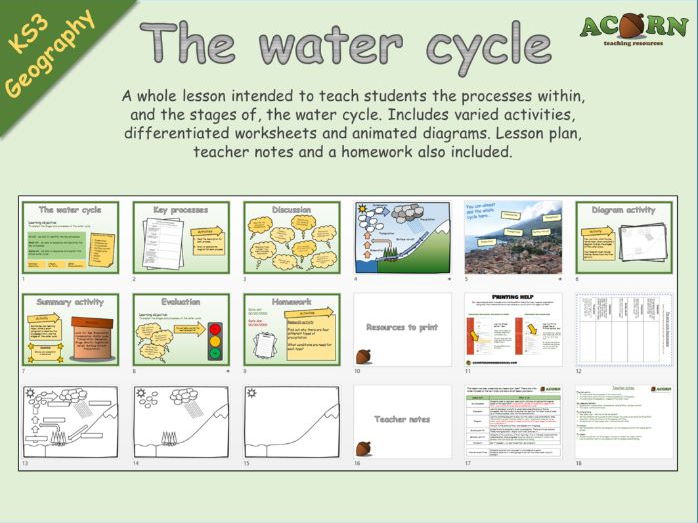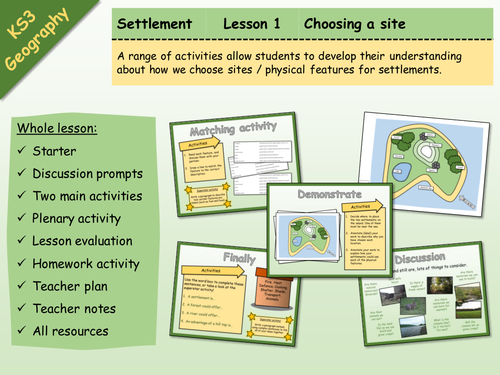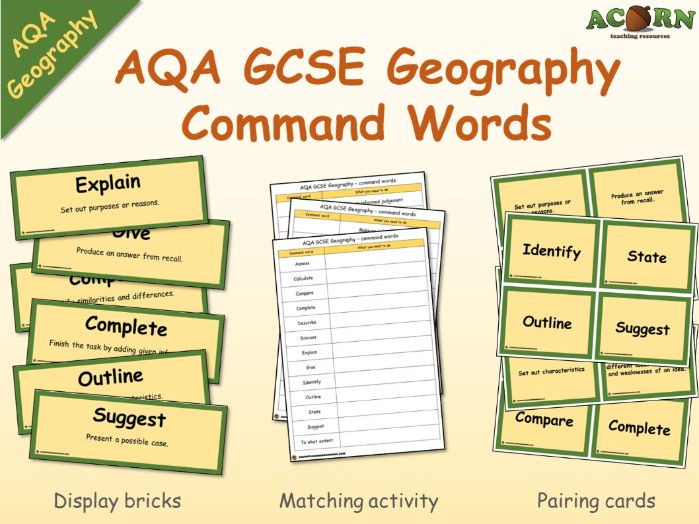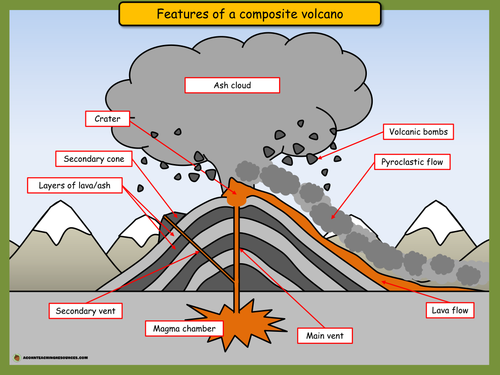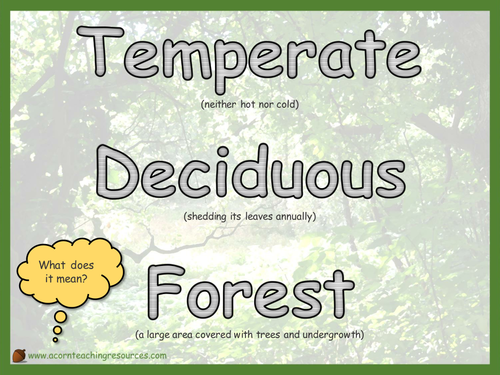66Uploads
152k+Views
57k+Downloads
Geography

Urban issues and challenges - Mumbai (social opportunities - healthcare and education)
A fully resourced and differentiated case study lesson teaching students about the social opportunities (health and education) in Mumbai – linking the content to the characteristics of Mumbai, and the wider processes of rural-urban migration.
Whole lesson > Key word starter > Discussion prompts > Key ideas > Comprehension / fact file task > Exam style questions > Class discussion > Learning evaluation > Summary activity > Mini plenary > Extension opportunities > Homework > Lesson plan > Teacher notes > Fully resourced > Visually attractive and ready to teach!
The main aim is…
For students to explore how Mumbai offers better social opportunities in terms of healthcare and education to it’s citizens and people migrating there.
To apply specific information about healthcare and education in Mumbai.
Key ideas and content…
Mumbai offers social opportunities people cannot find in surrounding rural areas.
Healthcare and education are both much more accessible in Mumbai than in surrounding rural areas.
These opportunities drive rural-urban migration.
To differentiate…
Several resources have been differentiated so all students can take part in each activity.
Paired and group work might be appropriate for the graph work.
WAGOLLS and model answers for writing a comparison.
Peer assess the plenary phone, using something such as two stars and a wish.
To extend…
Students could remove the Mumbai hospitals from the Maharashtra state total, and explain the significance of this upon rural-urban migration. Essentially this further proves the point about access to healthcare because Mumbai props Maharashtra up in terms of number of hospitals.
Students could form sentences using the key terms from the starter.
Instead of the plenary phone, students could write a formal letter allowing for more detail and application.
Students could develop their own mark scheme for the exam style questions.
To assess…
Use the exam style questions or the discussion prompts.
The plenary phone offers a mini-plenary assessment opportunity.

The Geography of Autumn
The Geography of Autumn gives students the opportunity to explore the interaction between people & environment and the Autumn season.
Students will apply atlas skills and explore interactions including: Autumn tourism, the impacts of global warming, animal migrations and cultural celebrations.
This is a structured and visually attractive lesson where the outcome is an informative piece of display work or a booklet. There are several ways the work could be completed over a range of time scales.

Urban issues and challenges - The emergence of megacities
AQA GCSE Geography - Unit 2 Section A - Urban issues and challenges - The emergence of megacities
An activity packed and differentiated lesson teaching students about the characteristics of a megacity, their growth and their location. Included is a wide range of resources which can be applied in many ways.
Whole lesson > Key concept starter > Discussion prompts > Key ideas > Map/distribution activity > Graph skills > Photo analysis > Exam style questions > Class discussion > Learning evaluation > Summary activity > Homework > Lesson plan > Teacher notes > Fully resourced > Visually attractive and ready to teach!
The main aim is…
To teach students about the characteristics of a mega city, their location, their growth (and reasons for it)
To link to key concepts such as urbanisation and migration.
Make it clear ‘world cities’ share many of the same characteristics – it’s the population, the magic number, which makes it a mega city.
Statistics and population data vary. For example, Paris has a population a little over 2 million, however, in some figures a wider area is taken into account. Make this clear to the students. The emphasis should really be on the growth (the emergence) of megacities in NEE’s.
Key ideas and content…
Mega cities have a population of over 10 million people.
They have similar characteristics – similar to those of world cities.
Their emergence is mostly in Asia and more recently, Africa. There is a pattern!
The number of mega cities has grown significantly over the last 50 years.
Rural-urban migration and natural increase are driving rapid urbanisation in LIC/NEE’s.
To differentiate…
Several activities have been differentiated already – use sheets as appropriate.
Discuss and model the exam style questions.
Allow independent / group thinking time for the discussion.
Provide the key terms as a checklist when answering questions.
To extend…
Students can add information / data to the maps.
The data could be presented in different ways.
Actual examples can be added to the photo analysis activity.
Students could develop their own mark scheme for the exam style questions.
To assess…
Use the exam style questions as an assessment opportunity.
Assess the distribution description to assess distribution questions.

AQA Geography A - The Restless Earth - Revision Sheet
Double sided A3 revision sheet built around the AQA Geography A Restless Earth module.
The sheet is structured around the Key Ideas, and has a range of activities.
Essentially, they're just populating the sheet as a revision tool
Does require exercise books / internet / textbooks.
Ideal as module revision, exam revision or lesson cover.

Geography - Easter Atlas Skills (scavenger hunt activity sheet)
Geography - Easter Atlas Skills (scavenger hunt activity sheet)
A double sided worksheet intended to use with pairs and small groups - all they need is an Atlas or two. Teacher notes are included with some suggestions. Basically, they are required to use an Atlas in several ways to find out a range of information (some of which is linked to Easter). There are a few other activities on the sheet (such as design an Easter egg).
Great for end of term activities, and will work with KS3 and KS4 students.
All reviews for our premium products have been 5/5* (As of February 21st 2017).

KS3 Geography - Settlement - Problems and benefits of settlement growth
Whole lesson with all resources included.
Learning objective: To explore factors affecting quality of life in large settlements.
Whole lesson:
Starter
Discussion prompts
Two main activities
Plenary activity
Lesson evaluation
Homework activity
Teacher plan
Teacher notes
All resources

GCSE Geography - AQA - Living with the physical environment - Types of natural hazard
New 9-1 AQA Geography
Living with the physical environment
A whole lesson intended to start Paper 1 ‘Living with the physical environment’ natural hazards section. The lesson will ensure students have a firm understanding of what a natural hazard is, and what the likely effects will be.
All resources included.
Teacher notes.
Differentiated activities.
Mixed activities.
Clear outcomes.
Discussion prompts.
Homework.
Learning evaluation.

Features of squatter settlements - differentiated activities
Two differentiated activities to include as part of your teaching of squatter settlements.
A photo analysis activity
Develop understanding of squatter settlements
Practise photo annotation skills
A table activity to extend understanding
Make links to living conditions and effects on the lives of people living in squatter settlements.
Activity planning guide
Teacher notes

Geography - Skills - Describing Places
A big lesson with lots of opportunity for differentiation and engagement, as well as paired or group work.
Basically, students learn how to describe places, and then apply this skill. It would work well as a skills building lesson in KS3, or as an end of term type lesson with either KS3 or KS4.
There are differentiated resources for lower and higher, and a number of ways in which the activities could be undertaken (which are in the lesson plan). There are teacher notes and a lesson plan. The activities are clear, and there are Superstar extension activities.
---
The main aim is…
This is a big lesson which could be used as an end of term activity, or as a skills building lesson.
Students either learn or develop their geographical terminology and then apply / demonstrate using photos of actual places.
Key ideas and content…
We can describe places using geographical language.
It is more effective to use the correct key terms and descriptive language.
To differentiate…
Pass the sheets round on a timer, with the challenge of either adding more key terms or improving existing ones.
Stick the sheets on the wall around the room, give each student a different key term to look for. Students go round the room.
Insist on certain terms being applied.
To extend…
Insist on a description of features which aren’t necessarily visible.
Students find their own photos and analyse them.
Peer assessment.
There are some tricky terms in the key terms activity, use to stretch students.
To assess…
Discussion points.
The work produced.
Peer assessment opportunity.

AQA Geography 9-1 Subject Specific Vocabulary - The challenge of natural hazards - Resources
Subject specific vocabulary resources
Section A: The challenge of natural hazards
A range of resources built around the AQA 9-1 Geography SSV for section A - The challenge of natural hazards.
Includes
- keyword bricks for display
- bingo game
- word mat
- teacher notes
All resources are included and are ready to print.
Keywords are grouped and colour coded.

Geography - The Africa Challenge
Ideal for KS3, but could be used with KS4. Introduce the continent of Africa and develop their spatial awareness of this massive continent.
These activities will help students develop their understanding about Africa as a continent of many countries.
The main activity is a challenge, where students use clues to work out where African countries are – not as easy as it seems!
There are also several extension questions which require students to use geographical language.
Ideal as an individual, paired or group activity.
Competitive element.
Develops spatial awareness and geographical language skills.
As of the 16th February, all of our premium resources have received a 5/5* review.

Geography - Settlement Shapes (Whole lesson)
Geography - Settlement Shapes (Whole lesson)
A whole lesson with a range of differentiated activities aimed at teaching students the features of, and differences between; linear, nucleated and dispersed settlement shapes.
Includes: snappy starter, animated explainers, key points, class discussion, differentiated activities, assessment opportunities, a homework task and lesson evaluation. All resources are included, along with a lesson plan and teacher notes.
The main aim is…
For students to learn the features of, and differences between linear, nucleated and dispersed settlement shapes.
Key ideas and content…
Nucleated, linear and dispersed are all settlement shapes.
Settlements grow in different shapes for different reasons.
Nucleated settlements will grow around a feature.
Linear settlements will grow along a feature.
To differentiate…
There is differentiation in the lesson.
Provide the essential words for the summary activity.
Students could work on the photo analysis together.
To extend…
Use the superstar activities.
Get the maps out / photocopy and cut out to pick out actual settlement shapes.
To assess…
The photo analysis and the summary activity allow progress to be demonstrated and assessed.
The homework could also be assessed.
All reviews for our premium products have been 5/5* (As of 21st February 2017)

Geography - The Water Cycle
A whole lesson intended to teach students the processes within, and the stages of, the water cycle. Includes varied activities, differentiated worksheets and animated diagrams. Lesson plan, teacher notes and a homework also included.
The main aim is…
To understand the processes of the water cycle
To understand where and why these processes are taking place
To understand the sequence / stages of the water cycle
Key ideas and content…
Evaporation, transpiration, condensation, precipitation, surface run-off
The water cycle is continuous
To differentiate…
See lesson plan / use the varied worksheets
Get the students up in groups to talk through the water cycle using the PowerPoint animation – before moving on to the diagram activities
Students can act (see lesson plan – alternative activities)
To extend…
Set the summary activity as homework / or the research activity for higher ability groups
To assess…
Students could act out the stages – choose at random for higher ability.
Use the summary activity as a piece of work to assess understanding.
Every review we've received for a premium resource has been 5/5* (As of February 20th 2017)

Geography - Coasts - Erosion - Coastal Landforms
Three labelled PPT diagrams to include in a lesson, to help when teaching...
- Cliffs and wave cut platforms
- Caves, arches, stacks and stumps
- Headlands and bays
Three worksheets to help students learn or demonstrate understanding. The worksheets have several tasks to help the students complete the diagram and link it to the processes of erosion.
As of the 20th January, every single review we've had for a premium resource has been 5/5*

KS3 Geography - Weather & Climate - How weather influences shopping
A range of activities allow students to develop their understanding about how the weather can influence what we buy and when.
Whole lesson:
Starter
Two main activities
Plenary
Homework
Discussion prompts
Teacher notes
All resources
Mixed activities (sorting, drawing, discussion and writing)

KS3 Geography - Settlement - 1 - Choosing a site
Whole lesson with all resources included.
Learning objective:
To learn why sites for settlements were chosen.
A range of activities allow students to develop their understanding about how we choose sites / physical features for settlements.
Whole lesson:
Starter
Discussion prompts
Two main activities
Plenary activity
Lesson evaluation
Homework activity
Teacher plan
Teacher notes
All resources

Geography - Living in squatter settlement - Activity sheets
Two activity sheets intended to be used as part of a lesson. The theme of the lesson should be along the lines of ‘Life in a squatter settlement’, and could be taught with KS3 or KS4 students.
Resource 1: the effects on peoples lives
The main aim is for students to appreciate how the conditions / characteristics of a squatter settlement affect people’s lives.
The task is for students to complete the sheet in a few different ways.
There are nine problems / effects associated with living in a squatter settlement. For each effect, they must list the associated problems, and for several, also draw the problem. Ask the students the question – how would this affect your life if you lived there? There will be some repetition.
There are three blank cards as well, these are intended for higher ability students, or for the teacher to edit so as to include a problem which may be appropriate to the theme of their teaching.
Higher ability students can cut the cards out afterwards and glue them in their exercise books – this is an opportunity to identify links between the problems. There are several, and the whole activity is very open ended. Students could also sort their ideas into social, political and economic – they could use three different colours and a key to show this.
There are some answers on the next sheet, although there are many more.
Resource 2: the informal economy of a squatter settlement
The main aim is for students to appreciate how people can earn money within a squatter settlement. The focus should be on how the work is informal and doesn’t contribute to the tax base / official figures. This kind of work can be contained within a squatter settlement, but not necessarily so. This is an opportunity to draw a strong link to rural-urban migration; how the residents are often uneducated and unskilled, but wanting and needing to work.
The task is simple, for each form of employment, the student must draw an appropriate illustration. Model for lower ability, ask higher ability to include speech bubbles, or some form of written communication. Use as an opportunity to clear up any misunderstanding about what each term means.
All reviews for our paid resources have been 5/5* (as of March 19th 2017)

GCSE - AQA Geography - Command Words
Includes a set of display bricks, a set of pairing cards and a matching activity sheet for students to fill in. These are the command words as dictated by AQA for the new GCSE geography specification.

Geography - Display - Temperate Deciduous Forest definition
Print in A3 and stick on the wall somewhere.

